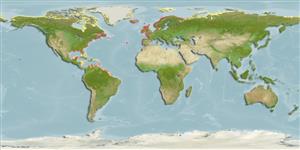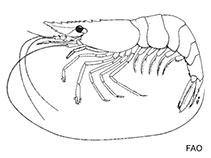Palaemonetes vulgaris (Say, 1818)
Marsh grass shrimp| Native range | All suitable habitat | Point map | Year 2050 |

|
| This map was computer-generated and has not yet been reviewed. |
| Palaemonetes vulgaris AquaMaps Data sources: GBIF OBIS |
Upload your photos
Google image | No image available for this species;
drawing shows typical species in Palaemonidae.
Google image | No image available for this species;
drawing shows typical species in Palaemonidae.
Classification / Names Common names | Synonyms | CoL | ITIS | WoRMS
| Decapoda | Palaemonidae
Environment: milieu / climate zone / depth range / distribution range Ecologia
; salmastro; distribuzione batimetrica 0 - 15 m (Ref. 97531). Tropical
Distribuzione Stati | Aree FAO | Ecosystems | Presenze | Introduzioni
Western Atlantic: USA and Canada. The Arctic. Tropical to polar climates of northern hemisphere.
Length at first maturity / Size / Peso / Age
Maturity: Lm ? range ? - ? cm
Often found near underwater structures and dense stands of aquatic macrophytes in shallow areas of estuaries. During the spawning season, the female molts and becomes receptive to the male. Copulation occurs within 7 hours after molting. Ova are externally fertilized on the ventral surface of the female abdomen. Fecundity is between 247 to 486 eggs per female. Eggs hatch 12 to 60 days after fertilization. After spawning, the female molts again. Larvae are planktonic and feed on zooplankton, algae, and detritus. Movement and distributional patterns likely influenced by both photoperiod and tidal cycles. Mainly detritivorous; also feeds on epiphytic microalgae and prey on meiofauna and small infaunal polychaetes, oligochaetes, nematodes, epiphytic fauna, and mysids. Preyed upon by various estuarine fishes and other aquatic carnivores. Host to numerous species of parasites and ectocommensals, primarily coccidia, microsporidians, trematodes, isopods, and leeches (Ref. 96311). Also on seagrasses and submerged vegetation (Ref. 97531).
Life cycle and mating behavior Maturità | Riproduzione | Deposizione | Uova | Fecundity | Larve
Members of the order Decapoda are mostly gonochoric. Mating behavior: Precopulatory courtship ritual is common (through olfactory and tactile cues); usually indirect sperm transfer.
Main reference
Bibliografia | Coordinatore | Collaboratori
Williams, A.B., L.G. Abele, D.L. Felder, H.H. Hobbs Jr., R.B. Manning, P.A. McLaughlin and I. Pérez Farfante. 1988. (Ref. 2214)
IUCN Red List Status (Ref. 130435)
CITES status (Ref. 108899)
Not Evaluated
CMS (Ref. 116361)
Not Evaluated
Threat to humans
Human uses
| FishSource |
Strumenti
Informazioni ulteriori
Age/Size
Accrescimento
Length-weight
Length-length
Morfologia
Larve
Abbondanza
Accrescimento
Length-weight
Length-length
Morfologia
Larve
Abbondanza
Fonti Internet
BHL | BOLD Systems | CISTI | DiscoverLife | FAO(Publication : search) | Fishipedia | GenBank (genome, nucleotide) | GloBI | Gomexsi | Google Books | Google Scholar | Google | PubMed | Tree of Life | Wikipedia (Go, ricerca) | Zoological Record



